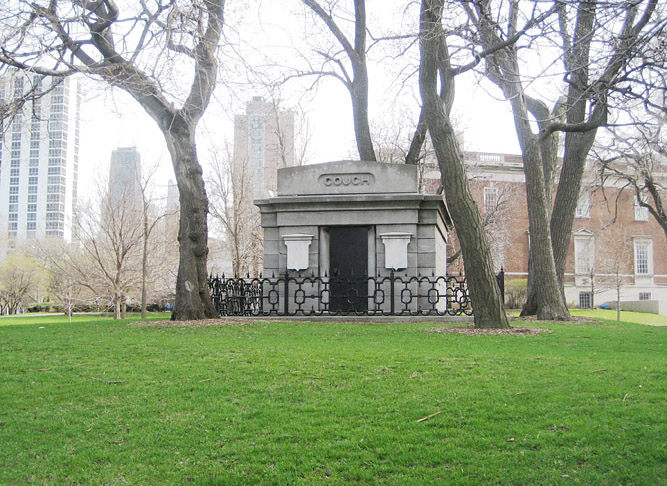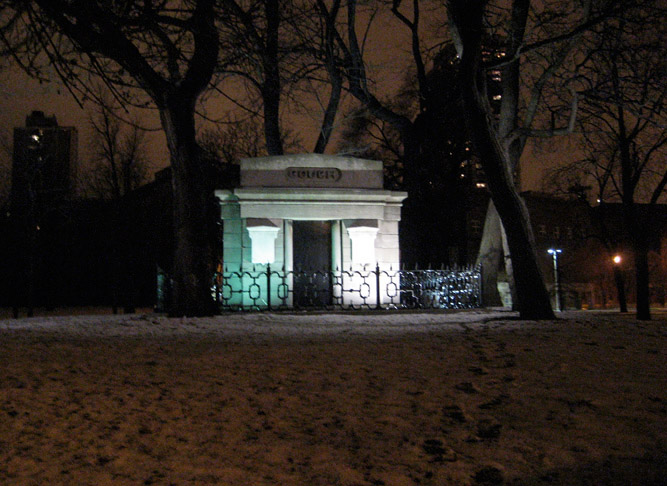| |
After nearly one hundred thirty years of neglect, and an original impetus to try to hide the massive stone vault, a decision was made to clean up the site and showcase the tomb. Today, it appears as a gleaming monument. It shines like a jewel in the night. A friend and colleague commented, "What other tomb is spotlit in such a display? Mussolini's?" Although still easy to miss in the landscape if one is paying attention to his/her driving while exiting Lake Shore Drive at North Avenue, the monument has a presence. It looks well-tended. There are no longer any bushes. There is no chain link fence. There is no broken glass or trash strewn about. It looks clean. It looks important. There is an informational signpost plaque explaining its history in the park. It feels like a major piece of Chicago history. It was designed by Chicago's first professional architect.
It is the oldest structure left standing in the Chicago fire zone.
Why has no one ever presented that fact?
____________________________________________________________ |
|

April 13, 2007 |

February 11, 2007
|
In a January 3, 1993, Chicago Tribune Sunday Magazine story about the tomb, Anne Keegan wrote, "The Couch tomb has fallen into a class of its own," says Julia Sniderman, supervisor of the Park District's preservation planning department. Part of a new master plan, she says, is to clean up the structure, tuck-point the stone blocks and landscape the area around the old forgotten tomb and "keep it as a symbol of the history of the park." ... After decades of being forgotten and hidden behind a scraggle of bushes and litter, with no marker to tell passersby what it is or why it is there, old Ira Couch's tomb is about to get a long-awaited face lift. And perhaps, some recognition.
"I guess that's nice," said a Chicago police officer whose beat several years ago included the mausoleum, which he had to check at night. "I never knew who Couch was until now. I just knew the name and that the tomb was overgrown and forgotten. At night we'd shine a light in there, and we'd see this homeless guy who'd made a little house for himself under the arches of the bushes surrounding the mausoleum. I'd see his face peeking out, we'd know then that he was in for the night, and we'd move on."
________________________________________________________________
(The Julia Sniderman quoted in the story, above, is now Julia Bachrach, the Chicago Park District Historian with whom I recorded a conversation about the early history of Lincoln Park. Listen to that conversation here.) |
In 1999, the renovated tomb, with a recreation of the original iron fence, and appearing in a purposefullly landscaped site, presented itself to Lincoln Park.
In a November 24, 1999 issue of Inside, a Lincoln Park neighborhood newspaper, there is a photograph of four people standing behind the new iron fence, with their backs to the tomb. The caption describes the scene as the dedicated ceremony that honored the Elizabeth Morse Charitable Trust's gift of $68,000 to the Parkways Foundation. That amount, in addition to other private donations to the foundation, paid for the replica of the original iron fence that was stolen, or otherwise disappeared, between 1911 and 1929. The sculptor, McKinley Wells, who recreated the fence, is standing in the group, along with a representative of the trust, and two members of the foundation. The caption also states the foundation gave $48,000 to the Chicago Park District to illuminate the tomb.
_______________________________
Ira Couch's tomb was built on-site in 1858 for $7000.
In 1877, it was deemed too expensive to remove at a cost of $3000.
In 1999, more than $116,000 was spent to clean it, fence it, and light it. |
|